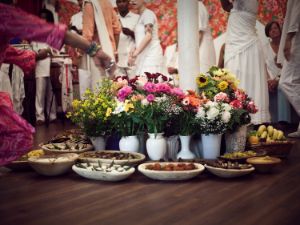Cleansing ritual and Oríkì performance | Rituals of Care
Baba Murah and Candomblé Berlin: The Magic of Healing

Candomblé-Ritual at Ilê Obá Sileké, 2019 Photo: Nico Beradi, courtesy: Ilê Obá Sileké & Forum Brasil e.V.
As part of the performance programme Rituals of Care, Baba Murah, the spiritual head of Berlin’s Candomblé Temple Ilê Obá Sileké, will perform a purification ritual with fellow believers in honour of the god of disease and healing in the atrium of the Gropius Bau.
Practitioners of the Afro-Brazilian religion Candomblé believe in the supreme creator Olorun and the Orixás – West African deities that form a link between the human and the spiritual world; various natural forces represent them. One fundamental principle of this matriarchal religion is a balance of forces: between human and nature, the spiritual and the material world, this life and the life hereafter. Disbalances are considered an illness to be rebalanced by healing and cleansing rituals.
Healing and Cleansing Ritual
In the atrium of the Gropius Bau, Baba Murah will perform a purification ritual with fellow believers in honour of the god of disease and healing: the Orixá Obaluaiê. When Obaluaiê’s mother Nanã – the Orixá of primaeval mud – abandoned her child because of his smallpox, the sea goddess Iemanjá saved him. Her saltwater healed Obaluaiê and turned his smallpox into white flowers. During the ritual, popcorn is used as a remedy and recalls this myth.
The altars of Obaluaiê, of Oxum – goddess of beauty and love, and the mistress of freshwater – and of Xangô – god of justice and fire – form part of the ritual.
Olubajé – Banquet of Healing
Candomblé’s complex mythology builds on various tales, the so-called Oríkìs, which are passed on primarily through drama, dance, singing, percussion and pantomime. Presented in the Gropius Bau, the dance theatre performs the tale Olubajé – Banquet of Healing:
Saddened and enraged by not being invited to the Orixás grand celebration, Obaluaiê withdrew his powers from heaven and earth: the sun ceased to shine, the plants withered, and the earth was barren. Following the advice of the oracle Ifá, the Orixás offered Obaluaiê their favourite dishes; they sang and danced in his honour. Obaluaiê was grateful, the sun emerged from behind the clouds, and the earth was fertile once more. The powers were rebalanced, and healing began.
Baba Murah is the spiritual leader of Ilê Obá Sileké, the only Candomblé temple in Germany. Founded in 2003, the temple has been located at the Zentrum Forum Brasil e. V. in Berlin-Kreuzberg since 2007.
Music: Valdir Juvenal, Leosinho Percussivo and Juninho Quebradera
Dance: Gil Guimarães, Meryl Prettyman, Carolina Schneeberg and Murah Soares
With the daughters and sons of Ilê Obá Sileké